EMBL Imaging Centre: 2024 Highlights

At the EMBL Imaging Centre (IC), we are proud to be at the forefront of cutting-edge biological research, providing access to state-of-the-art imaging technologies and expertise to scientists worldwide. Since opening our doors in the summer of 2021, we have supported nearly 300 projects from over 140 institutions and companies, reinforcing our role as a key resource for researchers across disciplines. In 2024, we have continued to develop and refine new technologies to meet the ever-evolving needs of the scientific community while maintaining the highest standards. Our highlights from the past year showcase the breadth and depth of our impact, from supporting crucial research on infectious diseases to driving technological innovation in imaging techniques. Discover captivating user stories in “From the bench to the EMBL Imaging Centre: when science meets art,” showcasing the real-world impact of our efforts.
Powering Infectious Disease Research
One of our major contributions in 2024 has been through the ISIDORe project, a European initiative tackling infectious disease research. Through ISIDORe, we have provided services at biosafety level 2 (BSL-2), enabling researchers to investigate viral mechanisms in safe and controlled environments. Specifically, we have supported projects using cryo-electron tomography (cryo-ET), super-resolution microscopy (e.g., STED and MINFLUX), and advanced tomography techniques. These cutting-edge tools have allowed high-resolution structural analyses of viral proteins, cellular interactions, and complex molecular mechanisms in diseases such as enterovirus, Nipah virus, Plasmodium falciparum, poxvirus, and CCHFV. Through optimised sample preparation, data acquisition, and advanced processing, we have facilitated crucial insights into viral replication, host-virus interactions, and the structural characterization of key viral components—advancing our understanding of these pathogens and supporting the development of targeted therapies and vaccines.
Visualising the Invisible
We are also proud to see our impact reflected in the growing number of publications of our users. In 2024 alone, we contributed to 16 publications. These publications demonstrate the power of advanced imaging in uncovering complex biological processes. Here are a few notable examples from 2024:
- Unveiling Brain Dynamics with MINFLUX: Researchers utilised MINFLUX microscopy at the IC to study the dynamic replacement of the synaptic scaffold protein PSD95 subunits in postsynaptic supercomplexes, revealing that this process is slowest in the cortex, offering insights into brain function and plasticity. (Morris K, et al. Sequential replacement of PSD95 subunits in postsynaptic supercomplexes is slowest in the cortex. eLife)
- A High-Resolution Look at DNA Repair: Cryo-EM was employed to determine the structure of the human full-length RAD52 protein at 2.2 Å resolution, providing crucial information for understanding DNA repair mechanisms and their role in cancer and other diseases. (Barboni B, et al. An integrative structural study of the human full-length RAD52 at 2.2 Å resolution. Commun Biol)
- Visualizing Ebola Virus Assembly: Using Correlative Light and Electron Microscopy (CLEM) at the IC, scientists investigated the assembly of the Ebola virus, revealing how nucleocapsid assembly drives viral factory maturation and dispersion, crucial for developing effective antiviral therapies. (Vallbracht M, et al. Nucleocapsid assembly drives Ebola viral factory maturation and dispersion. Cell)

Driving Technological Innovation
Beyond providing imaging services, we are always keen to drive technological advancements. Our collaborations with academic and industrial partners have led to significant developments, including:
- Building a Custom Single-Molecule Localization Microscope: A collaboration between the Zimmermann team and the Ries lab resulted in the development of a cost-effective, custom-built single-molecule localization microscope optimised for ultra-stable three-dimensional imaging and multichannel functionalities. This open-source design empowers researchers to build their own advanced imaging systems. (Power R, et al. Build and operation of a custom 3D, multicolor, single-molecule localization microscope. Nat Protoc)
Improving Cryo-EM Sample Preparation: In collaboration with industry partner CryoSol and other academic institutes, researchers developed a method for ice thickness control and measurement in the VitroJet, a crucial step for time-efficient single-particle structure determination in cryo-EM. (Henderikx RJM, et al. Ice thickness control and measurement in the VitroJet for time-efficient single particle structure determination. Journal of Structural Biology)

Training the Next Generation of Imaging Experts
We are committed to training scientists in advanced imaging techniques. In 2024, we provided individual training to 10 researchers from various countries and hosted a range of specialized training courses. A particularly inspiring story comes from a Latvian PhD student who underwent immersive training to accelerate his research career. The experience was highlighted in the article “Beginning a PhD at warp speed”. In April, we offered a hands-on workshop on Cryo-FIB lamella preparation and cryo-electron tomography which provided training on cellular sample preparation, FIB-milling, and tomography data collection. In May, an introductory course on volume electron microscopy familiarised undergraduate students with basic EM techniques and data analysis. June featured a summer school on cryo-FIB milling and in situ cryo-electron tomography, focusing on cryo-sample preparation, imaging, and data interpretation. Finally, in October, an autumn school on single-particle cryo-EM guided early-career researchers through sample preparation, microscope operation, and 3D reconstruction. Watch out for the course announcements in 2025, and do not hesitate to contact us if you are in need of training or interested in job shadowing!
Engaging the Community
We actively engage with the scientific community through events that are platforms for researchers to share their work, learn about new technologies, and forge collaborations. We hosted the EMBL Industry Workshop on Cryo-EM in Academia and Industry that brought together experts from academia and industry to explore the latest advancements in imaging technologies. Participants reflected on how cryo-EM has evolved over the past decade, with a focus on its integration into industry workflows, structural biology, and drug discovery. Later in the year, the EMBL Imaging Centre User Symposium 2024 took place in October, offering a unique opportunity for the user community to exchange knowledge and showcase their research. Covering a broad spectrum of imaging technologies—from cryo-EM to super-resolution and intravital imaging—the symposium featured expert talks, interactive discussions, and networking opportunities. These events aimed to foster collaboration, inspire innovation, and strengthen connections within the global imaging community.

Looking Back, Moving Forward
As EMBL celebrated in 2024 its 50th anniversary, it is important to reflect on the remarkable advancements in imaging technologies that have revolutionised biological research. Jan Ellenberg, Christoph Müller, and Matthew Hartley explore this history in their article, “Seeing is Understanding”, highlighting the pioneering work of scientists like Jacques Dubochet, who developed cryo-electron microscopy (cryo-EM) in the 1980s while at EMBL, enabling high-resolution observation of biomolecules in solution. This technique has been instrumental in structural biology, with researchers such as Steve Fuller applying it to study viruses like HIV. In 2015, EMBL envisioned a groundbreaking facility to democratise access to advanced imaging technologies. This vision led to the establishment of the IC, which became a reality in 2021 thanks to the generous support of partners like the Boehringer Ingelheim Stiftung and Heidelberg Materials. These collaborations, as highlighted in “12 Moments of Philanthropy”, have enabled EMBL to provide cutting-edge imaging services and training to the global scientific community, fostering innovation and expanding the frontiers of molecular biology research. As we continue to grow and evolve, our achievements in 2024 are a testament to the dedication and collaborative spirit that drive scientific discovery at EMBL. With ongoing advancements in technology, research, and training, we are ready to support the next wave of scientific breakthroughs in 2025 and beyond. If you are interested in our service portfolio, courses or learning more, feel free to reach out to us at ic-contact@embl.de!